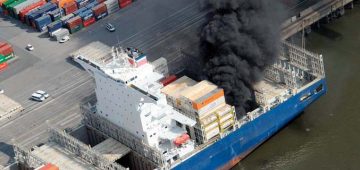Hanjin Shipping’s shares were suspended on 30th August after slumping 29% following its restructuring plans being rejected by creditors, putting the shipping line on the verge of bankruptcy. Hanjin Shipping had fixed liquidity problems and settled lower charter fees with tonnage providers as part of steps laid out by creditors with the aim of avoiding court receivership. A proposed injection of KRW400bn by sister firm Korean Air (later withdrawn) was deemed at least KRW200bn short by creditors, who noted that Hanjin Shipping’s liquidity shortages topped an eye watering KRW1 trillion. Hanjin Shipping had a debt of KRW6.6 trillion ($5.9bn) and a debt-to-equity ratio of nearly 850% at the end of 2015. The Korea Shipowners’ Association (KSA) had also come out in favour of pushing Hanjin to merge with Hyundai Merchant Marine.
On 31st August came the hammer blow that Hanjin Shipping had become the most high profile casualty of the container shipping downturn when its management opted for court receivership after its creditors had decided to end support for the struggling company. The 65,184gt/1998 built Hanjin Rome, a 3,700 TEU ship, was arrested in Singapore by a creditor on 30th August while another, the 141,754gt/2012 built Hanjin Sooho, was denied entry to the port of Shanghai. Other high profile Korean shipping companies that have gone under in recent years include Pan Ocean and Korea Line. South Korea’s financial regulator then confirmed that Hyundai Merchant Marine Co. Ltd. (HMM) will seek to acquire the healthy assets of Hanjin Shipping Co. Ltd. and is to have talks with Hanjin’s lead creditor, the Korea Development Bank, concerning future plans. CKYHE alliance partners Cosco, Yang Ming, K Line & Evergreen have rejected sharing space with the carrier, fearing that their customers could be affected if they continue the relationship as normal. Other slot agreements and ship deployments are also at risk with the remaining CKYHE members also not allowing Hanjin cargo onto their ships with CMA CGM also adopting this line. On 1st September Hyundai Merchant Marine announced that it was to deploy around 20 vessels on Hanjin Shipping’s routes to minimize the effects of the company’s filing for court receivership. HMM has added Hanjin’s America and Europe loops to its sea routes in an effort to minimize disorder in cargo delivery and damage to shippers.

The ships include four 4,000 TEU vessels on the U.S west coast route (Gwangyang-Busan-LA) from 8th September and nine 6,000 TEU ships on the European Union routes (NCP and Mediterranean main ports) with no fixed schedules announced. Hanjin Shipping then secured an injunction against the arrest of its assets in its native South Korea, and was considering sending its ships to Korean ports to keep them out of the clutches of creditors. The company is thereafter likely to apply for Chapter 15 in the U.S and the equivalent in 42 other jurisdictions including the U.K, thereby enabling it to trade in much of the world without fear of vessel arrests. Hanjin’s vessels have been valued at $1.7 billion whilst the debts exceed $5 billion. The 94,684gt/2016 built Hanjin Switzerland, owned by the Ciner group, was prevented from passing through the Suez Canal on 1st September whilst bound for New York. The U-turn was made because Hanjin lacks authorisation to spend money on canal fees. The company needs permission from the court to spend any funds it has. The Hanjin Group, parent company of Hanjin Shipping, was looking to raise KRW 100 billion ($90.4 million) in early September to be used to fund the unloading of cargo stranded on vessels following the company’s decision to file for court receivership. By 7th September it was apparent that Hanjin Shipping vessels were waiting for the company to receive bankruptcy protection in various countries before calling at port, even where terminals had agreed to service the ships and cargoes. The 113,042gt/2015 built and 10,000 TEU Hanjin Bosal was told not to berth in Valencia despite having received permission from Seoul to dock with a further 43 vessels circling or moored close to a port at that time. The general chaos surrounding the receivership of Hanjin Shipping plagued shippers around the world with around $14 billion of goods left stranded out at sea.
Two Hanjin Shipping vessels remained off the coast of California on 9th September, 82,794gt/2005 built Hanjin Boston and 40,542gt/2010 built Hanjin Montevideo, with a third moving south into Mexican waters, namely the 114,144gt/2011 built Hanjin Greece, probably to conserve her low-sulphur bunkers. The latter proceeded into Longbeach after 10 days once the arrest threat had been lifted. Seven Hanjin vessels managed by Reederi NSB were reported as at anchor for orders as of 9th September, namely the Hanjin Baltimore, Hanjin Boston, Hanjin Dallas, Hanjin Geneva, Hanjin Miami, Hanjin Vienna and Hanjin Yantian. Each of the vessels is beneficially owned by Conti Holdings GmbH. As the Hanjin Shipping empire crumbles, 2012 built handysize bulkers Hanjin Liverpool and Hanjin Isabel have been sold for $8m and $8.3m respectively whilst concern is growing for the crew and their supplies on the many stranded ships around the world. The number of ships idling in international waters for fear of being arrested had risen to 40. The Hanjin Mar and Hanjin Marine, both 4,500 TEU ships, were then sales listed with more to follow. Hanjin Italy, a 50:50 joint venture between Italy’s Gastaldi Group and Hanjin Shipping has also gone into liquidation with the loss of 92 jobs.

On 14th September Hanjin Shipping received a KRW40 billion ($35.5m) cash injection from the head of parent company Hanjin Group, Cho Yang-ho, as well as KRW10 billion from its former chief, Choi Eun-Young. This is part of the company’s earlier revealed plan to raise KRW100 billion to fund the unloading of cargo which was stranded on Hanjin’s vessels after the company filed for court receivership in late August. The Hanjin Group pledged to raise KRW 60 billion, while its chairman would provide the remaining amount from private funds.





Comments
Sorry, comments are closed for this item